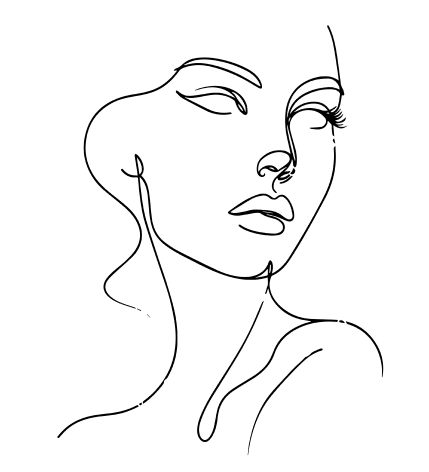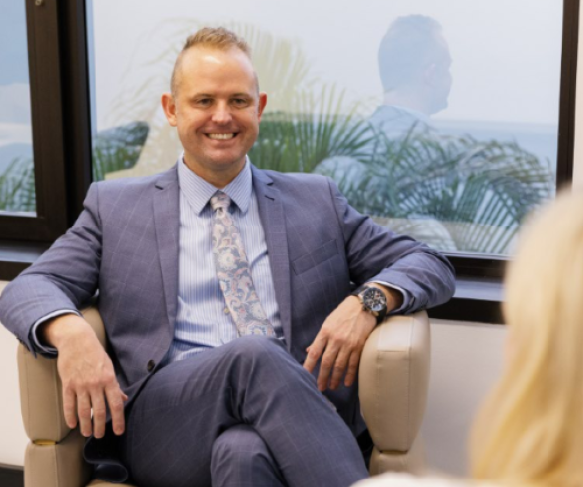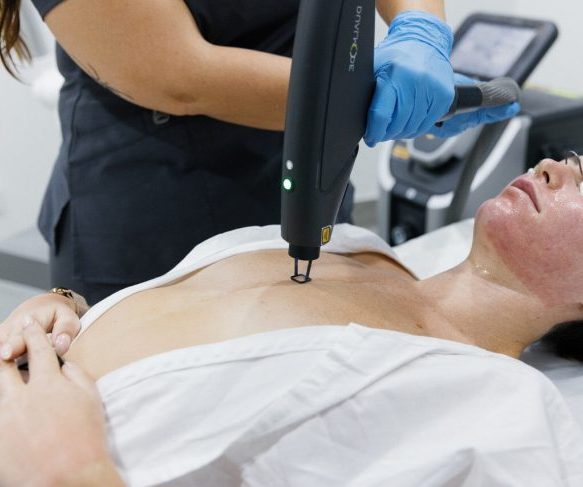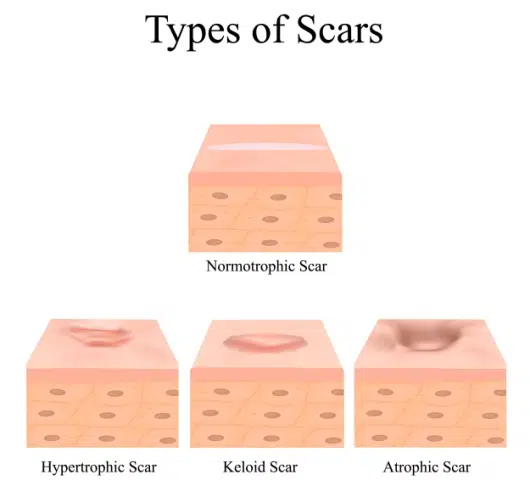Effective Treatments for Scar Reduction
LASER TREATMENT FOR SCAR REDUCTION BRISBANE
Scar formation is a natural part of the skin’s healing process, occurring after injuries, surgery, or skin conditions. The way scars develop can vary depending on factors such as age, genetics, skin type, and the location and severity of the injury. While some scars fade over time, others may remain visible and affect the skin’s texture, leaving many people feeling self-conscious or frustrated. Even with proper aftercare, scarring can be unpredictable, resulting in a range of appearances (e.g., flat, stretched, depressed, or raised).
Fortunately, there are treatment options available to improve the appearance of scars and support smoother, healthier-looking skin. Treatments such as laser therapy, RF microneedling, microneedling, or a combination of therapies can be tailored to individual skin and scar types, helping to address both texture and visibility.
Why scars develop
Scars are a natural part of the skin’s healing process. When the skin is injured (e.g., through surgery, accidents, acne, burns, or other trauma), the body works to repair the wound by producing collagen, a protein that helps close and strengthen the area. Unlike normal skin, scar tissue is structured differently and may appear thicker, thinner, or more textured than the surrounding skin.
Several factors influence how a scar forms and how it looks over time:
- Depth and severity of the injury: Deeper wounds often lead to more noticeable scars.
- Location on the body: Areas under tension or frequent movement may heal with more prominent scarring.
- Genetics and skin type: Some individuals are more prone to raised, thick, or pigmented scars.
- Age: Younger skin may heal quickly but produce thicker scars, while older skin can be thinner and more fragile.
Understanding these factors helps explain why scars vary between people and why treatment needs to be tailored to the individual.
TYPES OF SCARS
Scars can take different forms depending on how the skin heals and how collagen is produced. Understanding these types can help guide treatment decisions:
- Normotrophic scars: Flat and level with the surrounding skin, often fading naturally over time. Commonly seen after minor cuts, surgical wounds, or healed insect bites.
- Atrophic scars: Sunken or indented scars caused by loss of tissue. Examples include acne scars, chickenpox marks, and small surgical or injury-related depressions.
- Hypertrophic scars: Raised scars that stay within the boundaries of the original wound due to excess collagen. Often occur after surgical incisions, burns, or deep cuts.
- Keloid scars: Thick, raised scars that extend beyond the original injury and may continue to grow over time. Common in ear piercings, chest wounds, or certain surgical sites, and some individuals are genetically predisposed.
- Stretch marks (striae): Technically a type of scar, usually long, narrow, and slightly indented, forming when the skin is stretched rapidly, such as during pregnancy, rapid growth, or weight changes.
Book a Consultation and see how we can help you with visibly reducing the appearance of scars.

Benefits of Scar Reduction Treatment
Scar reduction treatments aim to improve both the appearance and texture of the skin while supporting overall skin health. Benefits can include:
- Smoother skin texture: Treatments help soften raised scars, fill indented areas, and improve overall skin surface.
- Reduced visibility of scars: Colour, redness, and pigmentation associated with scars can be diminished, making scars less noticeable.
- Improved confidence and self-esteem: Many people feel more comfortable in their skin as scars become less prominent.
- Support for natural healing: Therapies such as laser and microneedling stimulate collagen production and promote the skin’s regenerative processes.
- Customisable approach: Treatments can be tailored to your scar type, skin type, and goals, whether targeting small acne scars or larger surgical scars.
- Reduced discomfort: Certain scars can cause itching, tightness, or restricted movement; treatment may alleviate these symptoms.
Even though scars cannot always be completely removed, these treatments can lead to noticeable improvement in appearance, texture, and overall skin quality.
TREATMENT OPTIONS for SCAR REDUCTION
A variety treatments can help improve the appearance and texture of scars. The choice of therapy depends on scar type, skin type, location, and desired results. Any surgical or invasive procedure carries risks. Before proceeding, you should seek a second opinion from a qualified health practitioner.
- Chemical Peels – A medical-grade peel to exfoliate the top layers of skin. Helps improve superficial scars, uneven skin texture, and pigmentation.
- Microneedling – Uses fine needles to create tiny channels in the skin, stimulating collagen production and improving indented or atrophic scars.
- RF Microneedling – Combines microneedling with radiofrequency energy for deeper collagen stimulation, ideal for both texture and firmness improvements in scars.
- 1540nm Erbium Laser – Penetrates deeper layers of the skin to remodel tissue and stimulate collagen, suitable for atrophic and uneven scars.
- 2940nm Er:YAG Laser – Ablative resurfacing laser that removes superficial skin layers while stimulating collagen in deeper layers, effective for texture and prominent scars.
- Corticosteroid Injections – Used for hypertrophic and keloid scars to reduce thickness, inflammation, and discomfort.
- Subcision – A minor surgical technique where fibrous bands under indented scars are released, allowing the skin to lift.
Many scars respond best to combination approaches, for example microneedling with lasers or subcision followed by laser resurfacing, to address both texture and pigmentation. A personalised treatment plan ensures the best possible results while considering your skin type and scar characteristics.
Scar Reduction PROCESS at
Queensland Skin and Laser
Consultation
The process begins with a comprehensive consultation, where your clinician will examine your scars and assess their type, location, and severity. Your medical history and any previous treatments will also be reviewed to ensure a safe and personalised approach. During this appointment, we will recommend the most suitable treatment or combination of therapies, discuss expected outcomes, explain potential risks, and provide guidance on what to expect during recovery.
Treatment
On the day of treatment, the selected therapy is performed by a qualified clinician. Depending on your treatment plan, this may include laser therapy, microneedling, RF microneedling, chemical peels, corticosteroid injections, or subcision. Topical numbing or local anaesthetic may be applied to ensure comfort. The procedure is carefully targeted to treat scar tissue while protecting the surrounding healthy skin.
Aftercare
Following treatment, it is normal for the treated area to feel slightly red, sensitive, or swollen. You will receive detailed aftercare instructions to support optimal healing, including guidance on cleansing, protecting the skin, managing temporary side effects, and minimizing sun exposure. Proper adherence to aftercare recommendations helps ensure the best possible results.
Results
Scar reduction results develop gradually as the skin heals and collagen remodels. Depending on the type and severity of the scars, multiple sessions may be required. Over time, patients can expect improvements in texture, colour, and overall appearance. Results are long-lasting when combined with ongoing skin care and sun protection, providing smoother, healthier-looking skin.
Any surgical or invasive procedure carries risks. Before proceeding, you should seek a second opinion from a qualified health practitioner.
POssible Risks and Side Effects of Treatment
As with any medical procedure, there are potential risks and side effects, which can vary depending on the type of treatment, the area being treated, and individual skin characteristics.
Common temporary side effects may include redness, swelling, mild discomfort, or tenderness in the treated area. Laser therapy or RF microneedling can also cause minor peeling or flaking as the skin heals. In rare cases, patients may experience temporary changes in pigmentation (e.g., hyperpigmentation), particularly in individuals with darker skin tones.
Less common risks can include infection, prolonged redness, or blistering if aftercare instructions are not properly followed. Subcision and corticosteroid injections carry specific risks, including localized bruising, tenderness, or uneven results.
A consultation is essential to determine your individual risk factors and ensure proper preparation and aftercare to minimise complications.
How Much Does Scar REduction Cost?
The cost of scar reduction treatment depends on the type of treatment chosen and the number of sessions required. However, as a guide:
- Chemical Peels – from $149
- Microneedling – from $249
- RF Microneedling – from $300
- Laser treatments – from $150
You’ll begin to see visible results after your first session, however, most treatment plans include 3-5 sessions, spaced about 4 weeks apart. Package pricing may be available for multiple sessions. Your specific needs will be assessed during your consultation to determine the best plan for your concerns.
Why Choose Queensland Skin AND Laser
for Scar Reduction Treatment?
At Queensland Skin and Laser in Brisbane, our clinic is led by Dr Mark Chernoff and an experienced team dedicated to safe, professional skin treatments. We take time to understand your skin and scar type, and tailor our recommendations to suit you.
Expert-Led
Care
Led by Dr. Mark Chernoff, a seasoned physician with expertise in skin cancer detection, general and cosmetic dermatology, and advanced laser therapies, the clinic ensures high standards of care across all treatments.
Advanced
Technology
Queensland Skin and Laser integrates state-of-the-art laser systems, HIFU, RF needling, and photodynamic therapy, offering the latest in skin rejuvenation, tightening, and sun damage treatment.
Patient-Centred,
Boutique Experience
Patients experience a personalised, boutique environment where their concerns are met with unmatched professionalism and dedicated care.
Complimentary Cosmetic
Consultations
Clients receive a free consultation with the clinic’s cosmetic nurses, making expert skin advice accessible without upfront costs.
Flexible Payment
Plans
Offering weekly payment options through Zip Pay, the clinic ensures financial flexibility for both cosmetic and medical treatments.
Trusted Reputation
and Certifications
As a Fellow of the RACGP, an accreditation assessor, and an experienced dermatology professional, Dr. Chernoff and his team are recognised for their commitment to high standards, safety, and patient well-being.
Meet Dr Mark Chernoff
BSC (EXHP), MBBS (MELB), FRACGP, MFIN, CFTP
Dr Mark Chernoff earned a Bachelor of Science in Exercise and Health Physiology, followed by a Bachelor of Medicine and Bachelor of Surgery from the University of Melbourne in 2010. He began his postgraduate career at St. Vincent’s Hospital in Melbourne, specialising in general and plastic surgery.
Dr Chernoff serves as a Visiting Medical Officer in Emergency Medicine and works as a general practitioner in rural NSW. With extensive experience in skin cancer surgery, medical laser treatments and cosmetic medicine, he also contributes to medical education by supervising registrars for the Australian College of Rural and Remote Medicine and the Royal Australian College of General Practitioners.

How schedule a consultation
To book an appointment, click the button above, call 07 3544 6425, or email admin@qldskinandlaser.com.
Find us here:
- Level 2 – 445 Upper Edward St
Spring Hill QLD 4000
Frequently Asked Questions
SCAR REDUCTION TREATMENT BRISBANE
What is scar reduction treatment and how does it work?
Scar reduction treatments, such as lasers, microneedling, RF microneedling, chemical peels, or subcision, remodel scar tissue and stimulate the skin’s healing processes. The goal is to improve texture, colour and appearance of scars, rather than fully erase them. Book a clinical consultation to get started with a tailored plan.
How soon can I treat a scar after an injury or surgery?
You should wait until the wound has fully healed – no open skin, no active infection or inflammation – before undergoing scar‑reduction treatment. The timing depends on your wound, healing rate and treatment type. Your clinician will assess when your scar is suitable for treatment.
Which scar types benefit most from treatment?
Scars of different types respond differently to treatments. Raised scars (hypertrophic or keloid) may respond well to injections and lasers. Depressed (atrophic) scars often respond better to microneedling or resurfacing lasers. A thorough assessment will determine the most appropriate approach for your scar type. Book a free consultation today.
How many sessions does scar reduction usually require?
The number of sessions depends on scar severity, scar type, skin type, and the treatment chosen. Some patients achieve improvement after one session; others may need several treatments spaced out over weeks or months. Your clinician will provide a personalised plan.
Can the treatment remove the scar completely?
No treatment can guarantee full removal of a scar. However, many scars improve significantly in appearance and texture with appropriate therapy. The outcome will depend on the scar’s age, depth, location, your skin type and treatment compliance.
How should I care for my skin after scar reduction treatment?
You should follow your practitioner’s post‑care instructions. This generally includes gentle cleansing, applying recommended products, avoiding sun exposure and using high‑SPF sunscreen, refraining from picking or irritating the area, and attending any follow‑up visits. Good aftercare supports optimal healing and results.
Any surgical or invasive procedure carries risks. Before proceeding, you should seek a second opinion from an appropriately qualified health practitioner.

If you have additional questions about Scar Reduction, please complete the form below and we will get back to you shortly.


